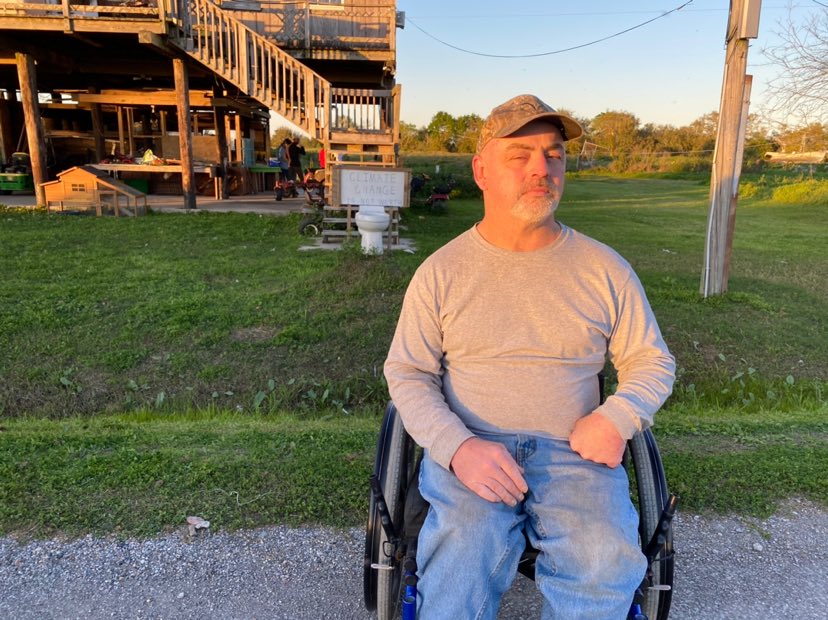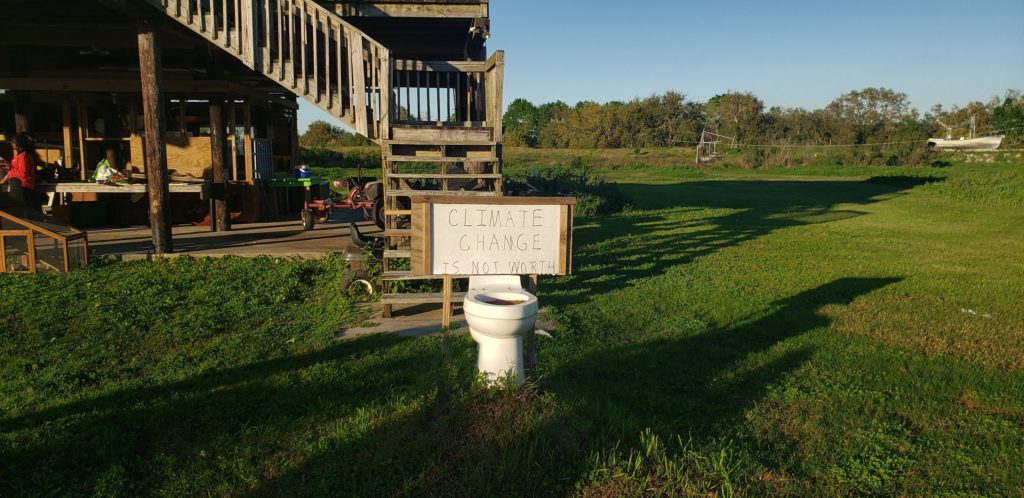When 54-year-old Chris Brunet noticed a group of young adults with notepads and cameras standing outside his stilt house, he excitedly rolled his wheelchair onto the powered lift to greet them with a big smile and a firm handshake. Brunet, a proud member of Isle de Jean Charles’ band of Biloxi-Chitimacha-Choctaw Indians, has grown used to the sight of inquisitive journalists. Some of these journalists called the people of his tribe America’s first climate refugees, yet a sign in Brunet’s front yard defiantly reads “Climate Change Is Not Worth…” above a toilet filled with brown soil.

“The big ol’ talk is climate change, climate change, climate change,” Brunet said while raising his arms in exasperation.
Today, Brunet and the remaining residents of Isle de Jean Charles are living through a relocation effort while water encroaches on their beloved, ever-shrinking isle. He’s sad to think of the possibility of losing the land that seven generations of his family called home and see his community scatter, but he’s not convinced that climate change is the main culprit.

“For us, when it comes to climate change, the problem is erosion,” Brunet said. “If you’re talking about the number one thing, it’s erosion.”
Brunet is more willing to point the finger at natural causes like hurricanes and land subsidence and human causes like boat traffic and dredged channels. That’s not to say that Brunet doesn’t recognize the existence of climate change, but when it comes to Isle de Jean Charles, it’s not the concern. Brunet was also hesitant to place blame on the oil industry, which plays such an important economic role in the lives of many Louisianans living near the coast.
“Man has played his part,” Brunet said. “The oil industry, I really can’t hit too hard on him, ‘cause down here if you weren’t building the tug, you was the captain of the tug, you know?”
How the landscape of the isle has changed over the decades cannot be ignored, though. While Brunet himself hasn’t noticed a major change, he recalled a story of his father growing up down the road from where Brunet lives now. One of his father’s favorite pastimes was to go fishing with friends at a local lake.
“He would be able to walk to the lake…and he would never walk in mud because it was dry land; it was marsh land, but it was dry because it was high,” Brunet said. “Now, we go to the lake by boat.”
Not only the land, but the way of life on Isle de Jean Charles was much different in his father’s time. Brunet said that his parents didn’t have modern amenities like electricity until the 60s.
“There’s whole life and death experiences of good and bad that went on over here that was part of the life,” Brunet said. “And it was not about making money, but it was about surviving. Some days were good, some days were bad.”
The bond between members of Brunet’s tribe was forged from generations of people living off the land and helping each other survive. Living down in the bayous of Louisiana gives the state-recognized groups of native peoples a unique history and culture.
“One of the things that gives this little place its own identity is that if you were Indian, then that’s where you belonged at,” Brunet said. “On the far end of the bayou out of everybody else’s way. And that not only goes for over here, but that goes for the bayou next to us in the east and along the coast.”
Brunet recalled sitting on a wooden chair with a tanned cowhide seat listening to stories told by his grandmother of the tribe’s history. Although Brunet has few physical possessions from his ancestors, their history and memories remain through stories.
“All that we have is the oral tradition,” Brunet said.
When the rising waters became a threat to his family’s traditional home, his grandmother raised it on stilts of timber in 2003 to escape the clutches of frequent flooding.
“She had got tired of hurricane mud and water getting into the house,” Brunet said. “But she didn’t want to leave the island.”
Besides a raised home, flood protection comes in the form of a small levee and a water pump behind Brunet’s back yard. But it’s not a perfect fix, as high winds and strong tides from the Gulf of Mexico can overwhelm both the levee and pump and take days to remove the water.
“If it wouldn’t be for that, by now I think I would have had maybe some low-level flooding,” Brunet said.
But Brunet said that the levee system could have been more comprehensive and effective. He said that back when the Army Corps of Engineers was designing the Hurricane Levee Protection System, it chose not to include Isle de Jean Charles from cost-benefit standpoint.
“That why with this relocation thing, we told the state from the beginning, ‘we weren’t included in the protection system, well then this [land] is ours,’” Brunet said. “I’m not moving over there and y’all taking this. This is mine.”
Under the guidance of their traditional tribal leader Chief Albert Naquin, many of the isle’s residents refuse to sell their homes to the state government. But at the same time, some like Brunet are still weighing the possibility of relocation. Leaving the land that he holds so dear to his heart is a daunting thought.
“Me and the kids, we used to take the afternoon and just take off walking and spend the whole afternoon talking to anybody outside on their porch.” Brunet said.
He fears what might happen if the closely-knit community spreads apart. And if the Isle de Jean Charles’ band of Biloxi-Chitimacha-Choctaw Indians do leave the land for good, Brunet is determined to retain their oral history and hopes their tradition will live on.
“That’s just something we’re going to have to work on,” Brunet said. “It’s going to be up to us.”